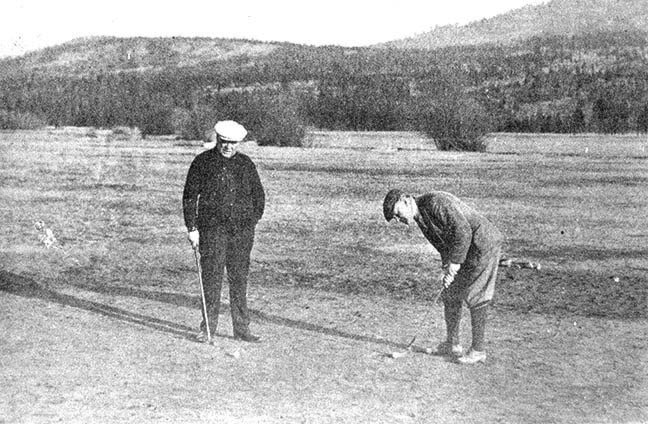It was the dawn of a new era. What had, two years before, been a landscape of wooded hillsides, streams, marshes and meadows was now the flourishing town of Cranbrook.
It was a land of opportunity and riches, a land where one might raise a family unencumbered by the crowds, crime, disease and squalor of the big cities; a place where a person might stand on the hills, gaze to the north along the flat open plain of Joseph's Prairie and envision the future; a future of hope and promise created with the toil of one's own hands sowing and hewing and, say, that's pretty flat land there to the north, whadya say to a couple quick rounds of golf before dinner?
It was inevitable that the game of golf must sooner than later come to the fore, given the wide open space and the numerous kilted Cranbrook pioneers. Although the roots of golf were firmly gripped by the Scots since (arguably) the mid-1500s, by the late 1800s the game was a popular pastime throughout the United Kingdom, the British Empire and the United States.
Cranbrook was no exception and on May 10, 1904, a like-minded group of enthusiasts met at the real estate offices of Beale and Elwell on Baker Street for the purpose of forming a golf club — that is to say a golf club formed of people rather than wood.
Under the slightly cross-handed title "The Kootenay Golf Club of Cranbrook," the group elected officers: Judge Forin and Solicitor S. F. Morley as Honorary Presidents. Others included store owner and future mayor G.T. Rogers as president, Bank of Commerce manager F.C. Malpas as vice–president and bank staff J.A. Motherwell and R.T. Brymner as captain and secretary/treasurer respectively, thus setting a high tone to the whole affair from hole one.
The group had already laid out a course somewhere near the eastern edge of what is now Slaterville and it was predicted that with the natural facilities for first class links the club would be a success in every way.
The course was in working order in little more than a week and within a month had drawn a number of admirers, many of whom took to the links themselves. Golf had arrived in Cranbrook.
It did, indeed, prove to be a successful year for the club, culminating on Oct. 6, 1904, with a social get-together at the Rogers residence where awards were presented in both men's and ladies' categories for the year-end competition, including "approaching, putting and long drive."
In those early days of Cranbrook golf, things were somewhat different. A full set of clubs would include a driving iron, cleek, mid mashie, mashie iron, spade mashie, mashie niblick, pitching niblick (best choice for tossing into the trees) and finally, the niblick, all of which more or less covered the modern irons 1 to 9 and which likely drove local tailor Niblock to distraction.
The more modern irons were introduced by the Spalding Sporting Goods Company in the early 1930s. A brassie, spoon and baffing spoon were among the necessary "woods" (some of which more closely resembled field hockey sticks). Golf balls from 1898 onwards were wound rubber thread covered with an outer shell of balata tree sap from South America, replacing the gutta-percha golf ball made from the dried sap of the Malaysian sapodilla tree (which was most probably discovered whilst searching for the aforementioned pitching niblick) which, in turn, replaced the hardwood ball or the "featherie" constructed of a hand-sewn leather pouch stuffed with the amount of goose or chicken feathers that could be held in a gentleman's top hat.
The year 1905 saw the club erect a "neat" clubhouse allowing members to stop to rest and enjoy a nice cup of tea, thus giving rise to conversational statements such as, "Now that you're in the club bring your clubs and we'll meet at the club at tea-time before tee-time."
Two weeks later a thief broke into the clubhouse and stole a number of sweaters and James Gill's gold watch, but that's another story.
It proved a successful season once again with the final competition held on Nov. 4, at a cost of fifty cents per entrant.
Successive years saw a gradual increase in membership as the course was improved by the addition of fencing and putting greens. The Kootenay Golf Club of Cranbrook seems to have entered a downswing during the years 1911 – 1914 for, in 1915, a meeting was held in city hall to organize a new club. The membership included many local names of note including V. Hyde Baker, George Hoggarth, E.L Staples, A.C. Bowness, Dr. Green and Dr. (later Senator) King. It was anointed the Cranbrook Golf Club and required a membership fee of $5 for men, $2.50 for ladies and $1 for the apparently ever-popular tea members. Dr. King and Mr. Staples supplied lumber for a new pavilion, later enhanced with an open brick fireplace. The membership count came in at over 40.
By 1918, the third year of operation, the club ended its season with a surplus of $95.65 and a membership of 43. Membership costs rose to $15 for men, $10 for women, $5 for outside and team members and a fifty-cent green fee.
In 1921 the Cranbrook Golf Club purchased 111 acres of land in the general area of what is now the Tamarack Mall and laid out Cranbrook's second golf course.
janusthenandnow@shaw.ca
